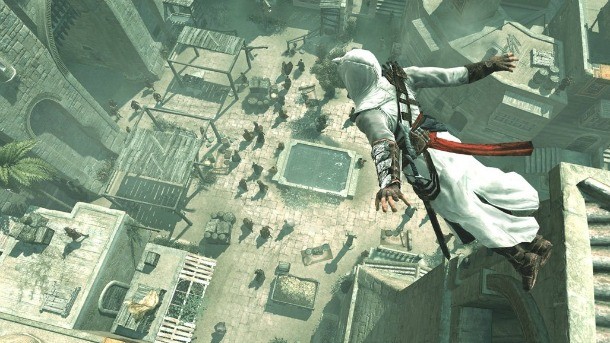Exploring Freedom In Assassin’s Creed

In honor of the 4th of July, we’re examining another angle on the concept of freedom – the video games that gave us a sense of freedom through story, gameplay, and controls. For me, few games have offered such a revelatory experience of free movement and exploration as the first time I played Assassin’s Creed.
In 2007, the idea of an open world gaming experience wasn’t a dramatic departure from the norm. Sprawling RPGs like The Elders Scrolls IV: Oblivion and crime epics like Grand Theft Auto III were already blockbusters, proving out the potential of having a massive world through which you could freely roam. Similarly, free-running 3D traversal and platforming was already an accepted path to exciting gameplay, notably in Ubisoft’s work on the Prince of Persia: Sands of Time series.
However, it was the melding of those two ideas in the first Assassin’s Creed that blew me away, and also set the stage for dozens of games in the coming years that would play off the concepts introduced in the series, whether that was free-running and parkour, climbing buildings, or rhythm-based combat.
My first experience with Assassin’s Creed came upon a visit to Ubisoft Montreal for a cover story on the game, several months before release. Few outside of the studio knew much about the game at that point, and I was going in largely blind, with little idea of what the game was about beyond a vague sense of its setting and and unusual premise. During the course of my trip, I experienced the game’s climbing, running, combat, and exploration first-hand, and the sense of freedom left me overwhelmed.
Looking back from the year 2014, it might be hard to recall what a big deal it was to be able to climb any building or cliff, or to run across rooftops in any direction. However, this was long before games like Infamous, The Saboteur, Prototype, or Batman: Arkham Asylum expanded upon the idea and made it commonplace. Assassin’s Creed presented a world filled with buildings to climb and crowds with which to interact. Unlike most previous traversal-focused games, there was no set path to reach that distant rooftop. Instead, I could push through the streets, or move above them. I could remain quiet and undetected or charge through killing foes as I moved. As one of the first games to offer this level of depth in exploring the world, I spent much of my time just enjoying the excitement of clambering along walls and leaping off high points.
The sense of freedom extended to mission design. In retrospect, many of the setup missions before a big assassination were repetitive. But, when I first played the game, the ability to choose between recon missions like pickpocketing and eavesdropping offered the sense that I was genuinely gathering info on my target through choices I had made. Once I had enough info, I had numerous paths I could take to confront my target, sneaking high along a fort wall, or forcing my way through a crowd of guards. After killing a target, there were numerous ways to escape the scene of the crime, and a tremendous thrill in getting away from my pursuers and tracking down just the right hiding spot to remain undetected.
That first installment of Assassin’s Creed may have been rough around the edges, but it established and popularized a number of gameplay paradigms that now dominate the action game genre, including in the many subsequent AC entries. Like many of the best games, Assassin’s Creed fulfilled a fantasy of something we wished we could do, but likely never would. In this case, that fantasy was all about uncovering the mysteries of a breathtaking historical locale, and investigating those ancient cities and their many nooks and crannies. When the game released, that depth of exploration and discovery had yet to be fully tapped in gaming. I’ve rarely been so thrilled by the potential for gameplay as I was the first time I climbed those medieval buildings to look out across an ancient city.

Get the Game Informer Print Edition!
Explore your favorite games in premium print format, delivered to your door.
- 10 issues per year
- Only $4.80 per issue
- Full digital magazine archive access
- Since 1991









